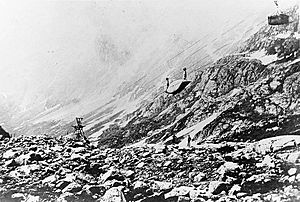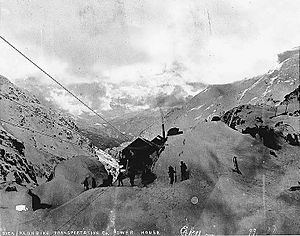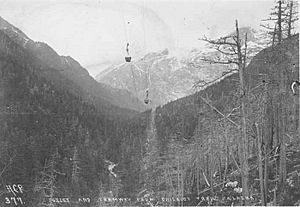Chilkoot Trail tramways facts for kids
The Chilkoot Trail tramways were special cable systems, like mini-cable cars, that helped people and supplies move during the Klondike Gold Rush. They were a big part of the Chilkoot Trail in Alaska, helping prospectors get their gear towards the gold fields near Dawson City, Yukon.
Four different tramways and one hoist (a simple lifting device) operated on the trail. However, they all closed before 1900. This happened because the White Pass and Yukon Route railroad was built, which became the main way to transport people and goods.
Early Ways to Move Gear
Peterson Hoist: A Simple Lift
The Peterson Hoist was one of the first systems built to help move heavy gear on the trail. It was set up in 1896. We don't know much about P.H. Peterson's hoist, not even its exact location. It might have been on a different path called Peterson Pass.
The hoist was quite simple. It had a pulley at the top of the pass with a rope running through it. A sled was attached to one end of the rope, and a box to the other. Workers would load gear onto the sled. Then, they'd fill the box with snow. Gravity would do the rest! As the heavy snow-filled box went down, it pulled the sled with the gear up. Once the sled reached the top, everything was emptied, and the process started again. Because it was so simple, it didn't leave many clues behind, which is why its location is a bit of a mystery.
Archie Burns' Tramway: From Horses to Steam
In the spring of 1897, Archie Burns started the first real tramway on the Chilkoot Trail. It ran from a spot called The Scales up to a false summit on the Chilkoot Pass. At first, horses powered this tramway. Burns also offered services to haul goods by hand from Dyea, Alaska to The Scales.
Later, in the winter of 1897-1898, a merchant named C.W. Young bought the tram. It became the C.W. Young Freighting and Trading Company, with Burns still managing it. Sometime between December 1897 and February 1898, the tram got an upgrade: it switched from horse power to steam power!
The C.W. Tramway was very popular because the Peterson Hoist was its only real competitor. It made a lot of money. By late February 1898, it was moving over five tons of freight every day! Burns later added a gasoline-powered hoist to help, which worked similarly to the Peterson Hoist but used gasoline instead of snow.
In January 1899, Burns bought the tram back from C.W. Young. By then, fewer prospectors were using the Chilkoot Trail. Burns closed his tram for good later that year and moved to Nome, Alaska. He returned in 1900 to collect valuable parts of the machinery, but many pieces of his operation are still found on the trail today.
Major Tramway Companies
Dyea-Klondike Transportation Company (DKT): Electric Power!
The Dyea-Klondike Transportation Company (DKT) arrived on the Chilkoot Trail in the fall of 1897 with big plans. They wanted to build a "narrow gauge tramroad" (a small railway) from their dock in Dyea up to The Scales. From there, an aerial tramway would carry gear over the pass. This would create a full transportation system from the water of Lynn Canal all the way into Canada.
However, like many big ideas during the gold rush, this one faced problems. The company, based in Portland, Oregon, ran into money troubles. So, they changed their plans. Instead of a tramroad, they used horses. But they still planned to build an aerial tram at the pass.
The DKT Company was based in Tacoma and used professional engineers. They built a "Bleichert style" tramway using parts from Trenton Iron Works. During construction in the spring of 1898, the crews faced tough challenges, including illness and dangerous avalanches. Despite this, they managed to put up towers and string heavy steel cables.
On March 17, 1898, the DKT opened its 2,400-foot (730 m) aerial tramway. They proudly announced it was "the only tramway in the world powered by electricity!" This was true. The electricity came from the company's power plant in Canyon City, which was originally meant to power the tramroad. You can still find ruins of a steam boiler at that location. Seven miles of power lines carried electricity from Canyon City up to The Scales for the tramway.
The DKT tramway broke Archie Burns' (and C.W. Young's) control over tramways on the pass. For almost a month, it was the only aerial tramway going over the pass.
The DKT's time as an independent company was short. In June 1898, just four months after it opened, the Dyea-Klondike Transportation Company joined forces with two other big tram companies: the Alaska Railroad and Transportation Company and the Chilkoot Railroad and Transport Company. They merged to work together better. In June 1899, the White Pass and Yukon Route railroad bought this combined tram company to avoid competition. They started taking it apart in the fall of 1899.
Alaska Railroad and Transportation Company (AR&T): A Strong System
The Alaska Railroad and Transportation Company (AR&T) built the second most advanced tramway system on the Chilkoot Trail. It was the second of three aerial tramways to be built.
The AR&T, which was part of the Pacific Coast Steamship Company, became interested in the Chilkoot Trail area around December 1897. They bought land for a dock in Dyea and built freight depots in Dyea and near Sheep Camp. Their original idea was to build a railroad up to The Scales and then an aerial tram over the pass. However, the railroad part of the plan was dropped soon after the company started.
Construction began, and around May 1898, their gas-powered, 6,000-foot (1,800 m) long aerial tramway was finished. Unlike the other tram companies, AR&T only operated the tramway itself. They didn't offer horse-hauling or other services. Their tramway was much better than the Dyea-Klondike Company's tram. It could carry more weight, was longer, and stronger.
However, its time as the main freight carrier in the Taiya River valley was also short. Soon, the Chilkoot Railroad and Transport Company finished their even longer, stronger, and more complete system. By June of the same year, all three tram companies merged and started charging the same prices.
It's believed the AR&T tram operated until June 1899. That's when the White Pass and Yukon Route railroad bought it. The railroad wanted to remove any competition for its own services. By March 1900, workers had removed everything valuable from the tram line, leaving only empty wooden structures.
Chilkoot Railroad and Transport Company (CR&T): The Biggest System
The Chilkoot Railroad and Transport Company (CR&T) built the largest, most complete, and last of the Chilkoot Trail tramways.
At first, they thought about building a horse-drawn tramroad or even a full railroad up the Taiya River valley. But money problems stopped these big plans. The company decided on a wagon road to Canyon City, followed by a two-part aerial tram system. The first tram went from Canyon City to Sheep Camp, and the second from Sheep Camp to Stone Crib. They also hired people to carry goods from Stone Crib to Lake Lindeman.
This system allowed CR&T to be the first company to offer a full transportation option. They could move prospectors' gear all the way from the docks of Dyea to the start of the Yukon River (at Lake Lindeman and Lindeman City).
Construction started in December 1897, and both trams were running by May 1898. Just a month after CR&T opened its trams, it merged with the Alaska Railroad Transportation Company and the Dyea-Klondike Transportation Company.
CR&T's system was used heavily until June 1899. That's when the White Pass and Yukon Route railroad reached Bennett Lake in British Columbia. This made CR&T's trams less needed. Even so, CR&T's prices were still similar to the railroad's. So, in 1899, the White Pass and Yukon Route bought CR&T's trams. They started taking them apart in January 1900 and finished by April of the same year.





